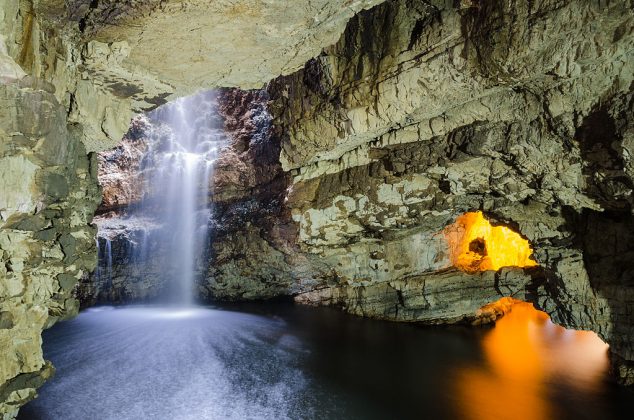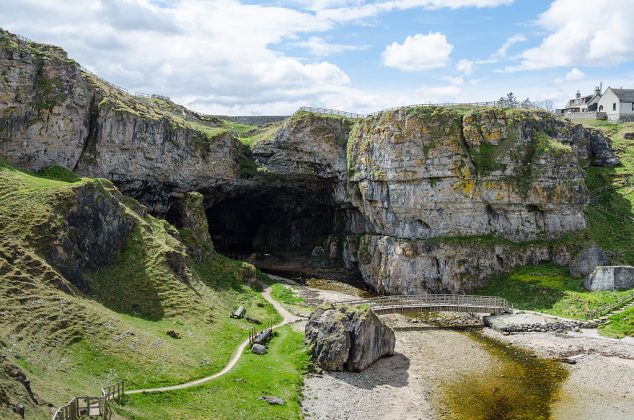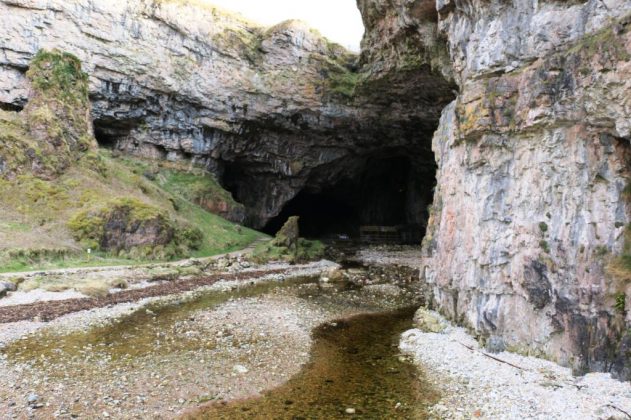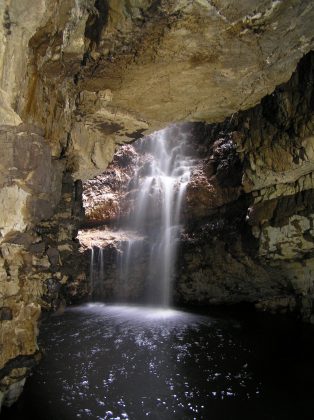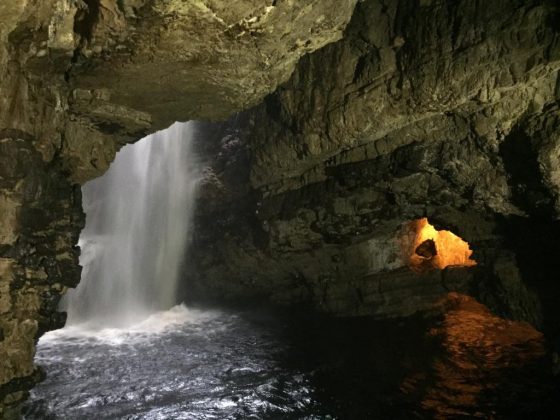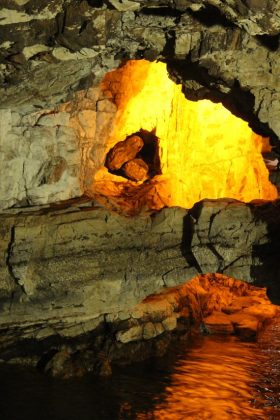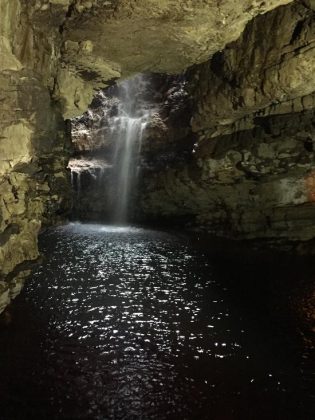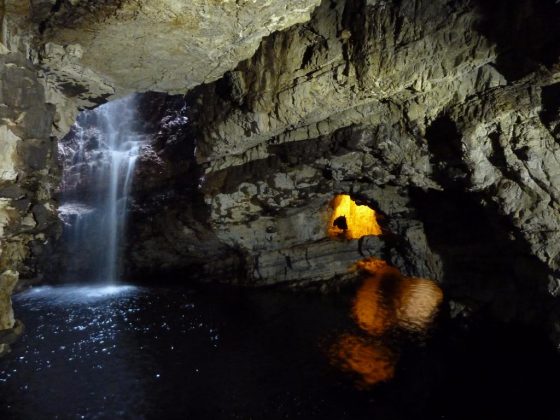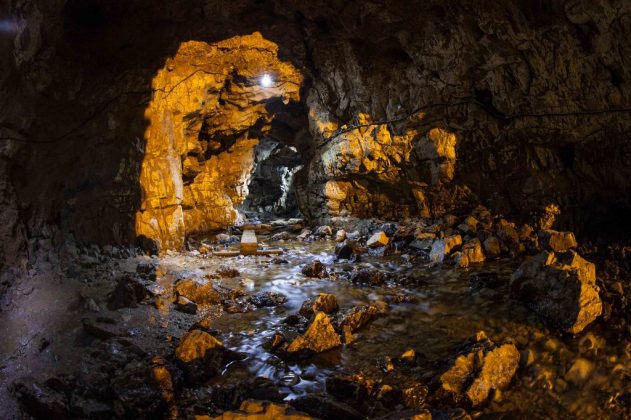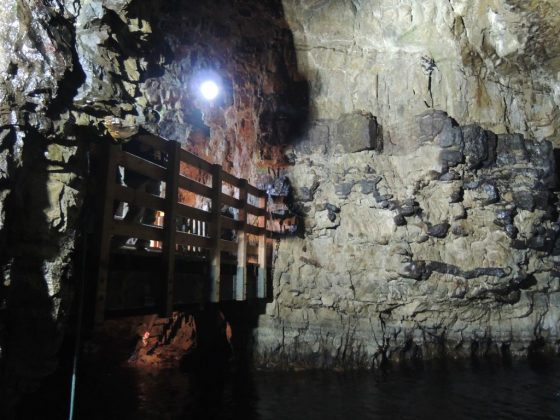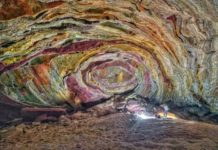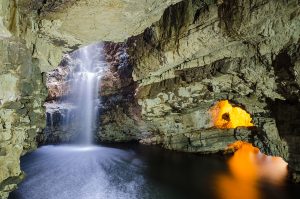
Smoo Cave is a large combined sea cave and freshwater cave in Durness in Sutherland, Highland, Scotland.
Smoo Cave is located at the eastern edge of the village of Durness, on Scotland’s most northerly coastline. It is a dramatic location and on the only primary road in the area, the A838 Durness to Tongue. A trip to Smoo Cave has to be included in any stay in Durness. Set into limestone cliffs, Smoo Cave is quite large – 200 feet long, 130 feet wide, and 50 feet high at the entrance.
Geology
Smoo Cave is a very large sea cave, but the rear part is a karst cave which formed inside limestones of the Durness Group. The Durness Group are layers of limestones and dolomites. The rocks were formed during Odovician and Lower Cambrian as shelf sediments. They are found in a narrow belt running north to south, from the area of the Smoo Cave to Ardarroch at Loch Kishorn. The karst features of Smoo cave are typical for such a small limestone area with impermeable and insoluble rocks surrounding it. Waters flowing on impermeable rock, disappear in swallow holes as soon as they reach the border to the limestone. They drain underground and reappear in karst springs and caves. Such a cave river is to be found inside Smoo cave, water from a burn which disappeared only a few meters away.
The cave is formed in a band of Durness limestone which in turn is surrounded by quartzite, gneiss and grits. Originally a small swallet cave, the entrance has been much enlarged by the action of the sea. The first chamber is the large opening from the sea inlet and has been formed by the action of the sea. The second chamber has been formed by the action of fresh water. The roof holes show the difference in the forces that formed the caverns.
The presence of caves in the vicinity of the Geodha Smoo, and indeed the presence of the Geodha itself, is a reflection of the character of the local geology, which is dominated by Cambrian Dumess Limestone.
Physical description
The cave is unique within the UK in that the first chamber has been formed by the action of the sea, whereas the inner chambers are freshwater passages, formed from rainwater dissolving the carbonate dolostones. Partway through the cave the waters of Allt Smoo also drop in as a 20m high waterfall. This is mainly due to the nearby dolostone – quartzite geological boundary where the Allt Smoo stream crosses the impermeable quartzites and sinks on meeting the permeable dolostones. Essentially the cave can be thought of as two caves formed by different mechanisms which have joined together over time. The cave is composed of three main sections; a large sea cave entrance chamber, a waterfall chamber and a short freshwater passage which leads to a terminal sump chamber with some interesting flowstone formations at the rear.
The cave entrance and main chamber have been considerably enlarged by sea action to approximately 40m wide and 15m high, the largest sea cave entrance in Britain. The entrance is located at the end of a 600m long tidal gorge (Geodha Smoo) which was once part of the cave, now collapsed. Several remnant pillars can be seen along the eastern side of the Geodh along with a large section of the previous roof which has been partly buried by the grassy slope (normally covered by rocks spelling out the names of visitors to the cave). Interestingly, the sea rarely enters the sea cave nowadays (only during spring tides) as the area has undergone isostatic uplift.
The present-day cave is 83m long up to the terminal sump at the rear of the third chamber / passage. The cave travels further however as an active stream of notable size resurges here at all times. Previous dye-testing has linked an underwater passage to an initial sink point in the Allt Smoo stream about 100m upstream from the main waterfall, implying that the cave system is at least twice as long as once thought. Cave divers belonging to the Grampian Speleological Group have dived this sump to a distance of c. 40m, although large volumes of silt and peat in the water have prevented further exploration. It is worth noting that the main waterfall is often dry and will only become active once this upstream sink overflows.
Archaeological investigations have turned up Neolithic, Norse and Iron Age artifacts, and it is thought that usage may extend back to the Mesolithic age. The cave name is thought to originate from the Norse ‘smjugg’ or ‘smuga’ meaning a hole or hiding-place.


